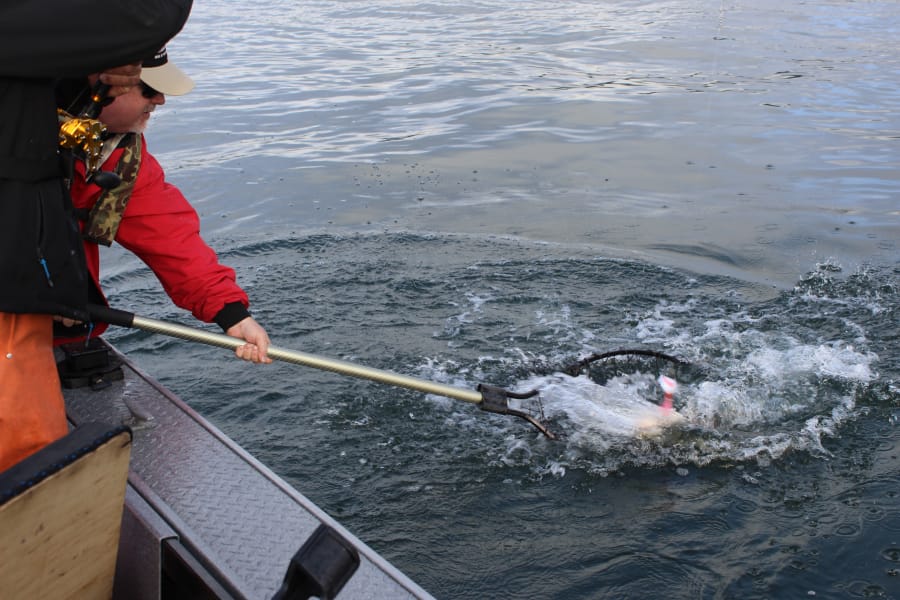The celebrated Buoy 10 fishery is a trolling show, and like every other aspect of Buoy 10 fishing, it is complicated. Ask any guide what works, and you will get different answers.
Some anglers favor baits such as herring and anchovies, and others will swear by spinners. Most will deploy offerings with lead weights, but a few still rock the divers to keep the bait in the kill zone.
However, when iconic fisherman Buzz Ramsey trolls Buoy 10, he employs a mixture of both baits and spinners to get the salmon to strike. His boat setup and his bait deployment are meant to maximize opportunities and tease the salmon into biting.
“I like to run spinners on my front rods,” Ramsey said. “The aggressive fish we pass will hit those. For the next rods back, I fish bait with flashers. These get the less aggressive fish interested with all that scent in the water.”
He will run his center back rod about 70 to 100 feet behind the boat and trailing the other gear. This rod will attract the attention of any less aggressive fish or others that were attracted by the flashers but got there too late to catch the front baits.
And then this last bait comes be-bopping along, and it often triggers strikes from those late or reluctant biters. It is an effective strategy, and it accounts for a lot of the fish that Ramsey puts in his fish box every year.
It’s also a good way to keep the lines from getting tangled with each other.
Ramsey runs 65-pound Berkley Braid as the main line, and he uses the Tracer version, which is color coded with high/low visibility in two and a half foot sections.
“What we like about Tracer is the fact that we can not only see it, but more importantly, we can see which way the line is going when someone hooks a fish,” he said. “If they are gaining line or the fish is taking line, I know it just by looking at the line. If the line was low visibility I wouldn’t be able to see it and if it was high vis I could see it but would not know which way the fish was running.”
He prefers leaders of 25 to 40-pound test Berkley Big Game line.
“With herring I use 25-pound test as its thinner diameter doesn’t tear the bait when snelled up,” Ramsey said. “We use 30- and 40-pound test leader when using spinners, since we place a swivel half way down our leader to reduce or eliminate line twist. We use 40 pound near the flasher and 30 pound from swivel to lure.”
Ramsey deploys 10- or 15-inch stainless wire lead droppers run on a Yakima Bait’s Free Sliding Spreader, which can also be rigged just ahead of a Fish Flash. The free sliding sinker line does not cause issues when netting the fish like a fixed dropper can.
Ramsey runs his heaviest lead on the front rods, and less with the back rods so they run further back and don’t tangle with the front lines. On the trailing rod he generally uses just four ounces of lead to keep it well back.
He runs an eight-inch Big Al’s Flasher either two feet behind the spreader, or right behind it. A four to five-foot leader runs back to the business end, which is a double hook rig for herring or anchovies. He uses 3/0, and 4/0 size Owner singles for herring leaders, with the size 3/0 as the trailer.
Good colors for flashers and spinners include chartreuse when it is cloudy or low-light, chrome when it is sunny, and sometimes salmon like green, blue, or orange. Coho salmon really like pink or red.
Remember that with the bait rods, you do not get in a hurry to grab the rod, and should let the fish take the bait and start peeling off line before you pull the rod from the holder. However, with a spinner, grab the rod quickly.
Barbless hooks are required for all salmon fishing on the Columbia, are unforgiving if you handle a fish wrong.
As for depth, watch your electronics to see at what depth the salmon are holding, and run your baits that deep or a little above. Also, troll with the current so you put your baits in front of more salmon.
The daily limit is one salmonid, either a Chinook or an adipose-clipped hatchery coho or steelhead. Always check the regulations before fishing.




